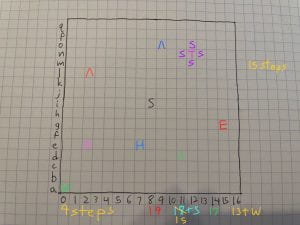How to Play:
- The game needs 2 people, one person plays as “Ike” or the Player, and the other plays as “Ashera” or the DM
- Ashera must place the board in front of Ike and place all the information and items face-down
- Lastly, Ashera shows the player the card that says that they are Ike
- Then the game starts
- Only Ashera can see the location of items and ensures that Ike is following the rules presented on the card
- Ike wins the game if he obtains Lehran’s Medallion
Artist’s Statement:
For this project, I had 2 initial goals: appropriate from Fire Emblem and make a game that is open-ended. I wanted to appropriate from Fire Emblem because I was heavily inspired by the series when coming up with the basic premise of the game. I had the idea to make a game where the player has a set amount of actions they can perform before they die so that every time they had a new life they were a little better off than before. Unlike a roguelike, I wanted to make the benefit of another life something more immaterial. With that, I settled on making lives useful because you would have more information about your surroundings. This is where the inspiration from Fire Emblem (specifically Fire Emblem: Path of Radiance) came into play. I could appropriate the grid-based movement system to make the player’s life equate to a number of steps, I could use famous items from the game to serve as tools to get you to your ultimate goal, and I could use lore from the series to contextualize your adventure. Lastly, I wanted to make sure that the players’ approach to the game was open-ended. This was inspired by the Dada Movement and from games like Super Metroid that emphasized trying new things and not explaining a lot. I wanted the player to interpret the board and realize what was happening on their own, so I did not give much information to the player.
This work relates to the Dada Movement for a few reasons. The first reason is that I used images from another artist and used them in a constructive way for my game. Dada artists often took images from other places and used them in collages, especially in cities like Hannover. Another way this relates to the Dada Movement is that I used lore or a story from another place to influence my work. The reading Dada artists in Cologne were often inspired by Christianity when making their works. My game took the story of Fire Emblem: Path of Radiance and adapted it. Lastly, I built my game to be open-ended and ordinary-looking. The game is made with simple paper and the only materials you need are your mind and the paper (though a pencil helps). The way the game is played is also very open-ended because there is nothing saying what you should do on a life, only an end goal and 1 restriction. This is similar to how Dada artists like Duchamp took ordinary objects like a chair and bicycle and transformed them into an open-ended piece of art.
Documentation:
- Game being Played
- Item & Information Sheets
- Documentation of Puzzle Solution:

